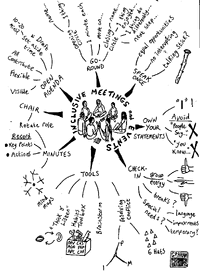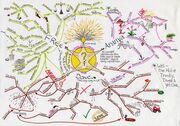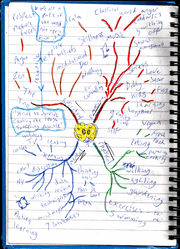A mind map (or mind-map) is a diagram used for linking words and ideas to a central key word or idea, often used in permaculture teaching, meetings and other events, eg, for note-taking, recording minutes, etc. It is used to visualize, classify, structure, and generation|generate ideas, as well as an aid in study, problem solving, and decision making.
It is similar to a semantic network or cognitive map but there are no formal restrictions on the kinds of links used. Most often the map involves images, words, and lines. The elements are arranged intuitively according to the importance of the concepts and they are organized into groupings, branches, or areas.
In other words, a mind map is an image-centered radial diagram that represents semantic or other connections between portions of information. The uniform graphic formulation of the semantic structure of information on the method of gathering knowledge, may aid recall of existing memories. It is also advertised as a way of increasing motivation to work on a task. For example, the map can graphically illustrate the structure of government institutions within a state. A mind map well-structured and well-established can be subject to review (e.g. with spaced repetition).
Origins[]
Mind maps (or similar concepts) have been used for centuries, for learning, brainstorming, memory, visual thinking, and problem solving by educators, engineers, psychologists and people in general. Some of the earliest examples mind maps were developed by Porphyry of Tyros, a noted thinker of the 3rd century as he graphically visualised the concept categories of Aristotle. Ramon Llull also used these structures of the mind map form.
People have been using image centered radial graphic organization techniques referred to variably as mental or generic mind maps for centuries in areas such as engineering, psychology, and education, although the claim to the origin of the mind map has been made by a British popular psychology author, Tony Buzan. He claimed the idea was inspired by the general semantics of science fiction novels, such as those of A. E. van Vogt and L. Ron Hubbard. He argues that 'traditional' articles rely on the reader to scan left to right and top to bottom, whilst what actually happens is that the brain will scan the entire page in a non-linear fashion. He also uses popular assumptions about the cerebral hemispheres in order to promote the exclusive use of mind mapping over other forms of note making.
More recently the semantic network was developed as a theory to understand human learning, and developed into mind maps by the rennaisance man Dr Allan Collins, and the noted researcher M. Ross Quillian during the early 1960s. As such, due to his commitment and published research, and his work with learning, creativity, and graphical thinking, Dr Allan Collins can be considered the father of the modern mind map.
The mind map continues to be used in various forms, and for various applications including learning and education (where it is often taught as 'Webs' or 'Webbing'), planning and in engineering diagramming.
When compared with the earlier original concept map (which was developed by learning experts in the 1960s) the structure of a mind map is a similar, but simplified, radial by having one central key word.
Uses of mind maps[]

Mindmap of techniques for running successful and inclusive meetings and events

A hand-drawn mind map

Rough mindmap notes taken during a course session
Mind maps have many applications in personal, family, educational, and business situations, including note-taking, brainstorming (wherein ideas are inserted into the map radially around the center node, without the implicit prioritization that comes from hierarchy or sequential arrangements, and wherein grouping and organizing is reserved for later stages), summarizing, revising and general clarifying of thoughts. For example, one could listen to a lecture and take down notes using mind maps for the most important points or keywords. One can also use mind maps as a mnemonic technique or to sort out a complicated idea. Mind maps are also promoted as a way to collaborate in colour pen creativity sessions.
Software and technique research have concluded that managers and students find the techniques of mind mapping to be useful, being better able to retain information and ideas than by using traditional 'linear' note taking methods. Template:Citation needed
Mindmaps can be drawn by hand, either as 'rough notes', for example, during a lecture or meeting, or can be more sophisticated in quality. Examples of both are illustrated. There are also a number of software packages available for producing mind maps (see below).
Mind map guidelines[]
These are the foundation structures of a Mind Map, although these are open to free interpretation by the individual:
- Start in the centre with an image of the topic, using at least 3 colours.
- Use images, symbols, codes and dimensions throughout your Mind Map.
- Select key words and print using upper or lower case letters.
- Each word/image must be alone and sitting on its own line.
- The lines must be connected, starting from the central image. The central lines are thicker, organic and flowing, becoming thinner as they radiate out from the centre.
- Make the lines the same length as the word/image.
- Use colours – your own code – throughout the Mind Map.
- Develop your own personal style of Mind Mapping.
- Use emphasis and show associations in your Mind Map.
- Keep the Mind Map clear by using Radiant hierarchy, numerical order or outlines to embrace your branches.
(See: BUZAN, Tony. The Mind Map Book. Chapter "Mind Mapping Guidelines").
Scholarly research on mind maps[]
Buzan (1991) claims that the mind map is a vastly superior note taking method because it does not lead to the alleged "semi-hypnotic trance" state induced by the other note forms. Buzan also claims that the mind map utilizes the full range of left and right human cortical skills, balances the brain, taps into the 99% of your unused mental potential, and taps into your intuition (which he calls "superlogic"). There has been research conducted on the technique which suggests that such claims may actually be marketing hype based on misconceptions about the brain and the cerebral hemispheres (see Human brain#Popular misconceptions). Template:Citation needed
There are benefits to be gained by applying a wide range of graphic organizers, and it follows that the mind map, specifically, is limited to only a few learning tasks. Research by Farrand, Hussain, and Hennessy (2002) found that the mind map technique had a limited but significant impact on recall only, in undergraduate students (a 10% increase over baseline for a 600-word text only) as compared to preferred study methods (a −6% increase over baseline). This improvement was only robust after a week for those in the mind map group, and there was a significant decrease in motivation compared to the subjects' preferred methods of note taking. They suggested that learners preferred to use other methods because using a mind map was an unfamiliar technique, and its status as a "memory enhancing" technique engendered reluctance to apply it. Pressley, VanEtten, Yokoi, Freebern, and VanMeter (1998) found that learners tended to learn far better by focusing on the content of learning material rather than worrying over any one particular form of note-making.
Tools[]
These tools can be used effectively to organise large amounts of information, combining spatial organisation, dynamic hierarchical structuring and node folding.
Free/Libre/Open-Source Software[]
- FreeMind is a free open source mind-mapping application written in Java
- VYM for Linux and MacOS Free Software (GNU/GPL).
- Kdissert for Linux only Free Software (GNU/GPL) for the creation of other documents from mindmaps: presentation, reports, applets.
- DeepaMehta Opensource Mindmap desktop
- WikkaWiki [1] is a free PHP/MySQL wiki engine with native support for FreeMind maps.
Commercial / proprietary software[]
- MindView is a professional mind mapping software that offers advanced features for brainstorming, project planning, and task management.
- Eylean Board is a project management tool based on the visual representation of tasks.
- Teamhood is task and project management software that allows to draw task dependencies and visualize the process.
- FlexusNetresources for mind mapping and business mapping in spanish
- MindManager is commercial mind-mapping software running on MS Windows and integrated with MS Office.
- NovaMind is a commercial mind-map application for Mac OS X. Features include arbitrary branch shapes, a branch proposal system, and integrated screenplay support.
- MyMind is a mind mapper with built-in outlining functionality. It is "donationware" for Mac OS X.
- i2Brain takes the next step - away from a flat tree to a network of ideas with depth. Multi-platform.
- ConceptDraw MINDMAP Mind Mapping, Brainstorming and Project Planning software that works both on Windows and Mac OS X
- OpenMind - software used by British schools
- MindGenius is commercial mind-mapping software for MS Windows with a vast array of features. This product is sleek and simple, with excellent export.
- SmartDraw, a visio-like product.
- Mindjet is one of the more robust of programs, with lots of visual features including on-screen notes, highlighting of sections, arrows outside of the tree structure, etc.
- BrainMine's major advantages come from an extensive graphics (icon/image) package, a convenient overview map, and an object attribute panel. The final products can be visually impressive, but the interface can be overwhelming (even distracting) for basic idea organizing.
- Visual Concept touts itself as a mind mapping program. The final product is more like visio, but seems to emphasize hexagon shaped maps.
- InfoRapid KnowledgeMap achieves some of the same MindMap type organization, but is constructed to seem more like an outline.
- Cornerstone is a visual thinking tool that supports a variety of visual styles.
- Aviz Thought Mapper : Thought Mapper is the cheapest commercial mind mapping tool available in the market with full functionalities . It integrates with MS Office & Outlook. It is built on Java technology & is available for windows as well as linux operating systems.
- Creately Mind Mapping: Its an WYSIWYG type online diagramming and collaboration tool built with flash action script to come up with beautiful find maps. There are many templates and examples of mind maps and it works with all platforms.
- iMindQ: is positioned as a premier mind map software is a great tool that incorporates many types of map styles for business, educational and personal use that could be used by any department in an organization, School system or University. In addition, iMindQ can help individuals stimulate learning, organize and visually present ideas.
Mind mapping in contrast with concept mapping[]
The mind map can be contrasted with the similar idea of concept mapping. The former is based on radial hierarchies and tree structures, whereas concept maps are based on connections between concepts. Concept maps also encourage one to label the connections one makes between nodes, while mind maps are based on separated focused topics; both of them have been found to enhance meaningful learning while enabling the potential as a true cognitive, intuitive, spatial and metaphorical mapping.
Trademarks[]
The use of the term "Mind Maps" is trade-marked by The Buzan Organisation, Ltd. in the UK [2] and the USA [3], though the trade-mark does not appear in the records of the Canadian Intellectual Property Office [4].
References[]
- Buzan, T. (1991). The Mind Map Book . New York: Penguin.
- Farrand P, Hussain F, Hennessy E. Med Educ. (2002) "The efficacy of the 'mind map' study technique". May;36(5):426-31. EBSCOHost. Retrieved May 5th, 2005.
- Novak, J. D. (1993). How do we learn our lesson? : Taking students through the process. The Science Teacher, 60(3), 50-55.
- Pressley, M., VanEtten, S., Yokoi, L., Freebern, G., & VanMeter, P. (1998). "The metacognition of college studentship: A grounded theory approach". In: D. J. Hacker, J. Dunlosky, & A. C. Graesser (Eds.), Metacognition in Theory and Practice (pp. 347-367). Mahwah NJ: Erlbaum.
- Novak A ,Hermann W., Bovo V (2005) Mapas Mentais: Enriquecendo Inteligências- Manual de Aprendizagem e Desenvolvimento de Inteligências"; ( p XI 27, 331). Ed IDPH
External links[]
- MatchWare is the commercial site for the creators of MindView and other software
- Flexus Groupis a commercial site with many business and personal mindmapping applications
- MindGeniuscommercial with many resources and mapping ideas
- Mind mapping software for MAC and PC
- Thinking with Pictures resources and information about model maps and concept maps
- Mind mapping software for writing dissertations and essays
- Buzan Centres
- High quality free mind mapping software
- Some good pictures at msoworld
- http://www.mapyourmind.com/ - A commercial site promoting mind-mapping and mind-mapping software
- IAResearch - A commercial site promoting mind-mapping and mind-mapping software
- http://web.archive.org/web/20091027093829/http://www.geocities.com/buzanguru/MindMapping1.html — mind map overview and advocacy
- Some more example maps on a commercial site
- http://www.petillant.com/ - French portal dedicated to mind mapping
- http://www.innovationtools.com/resources/mindmapping.asp - Mind mapping resource center.
- I-Navigation Mind mapping software with focus+context visualization.
- Mindmapping Outliners — an analysis of mindmapping and an overview of various products for Macs
- Beyond Crayons — A series of essays about the professional use of mapping software
- Mind Map Templates - A collection of free mind mapping templates that can be used to draw mind maps.
- 50+ FREE Templates - Collection of 50+ FREE mind mapping templates by iMindQ
| This page uses Creative Commons Licensed content from Wikipedia (view authors). |